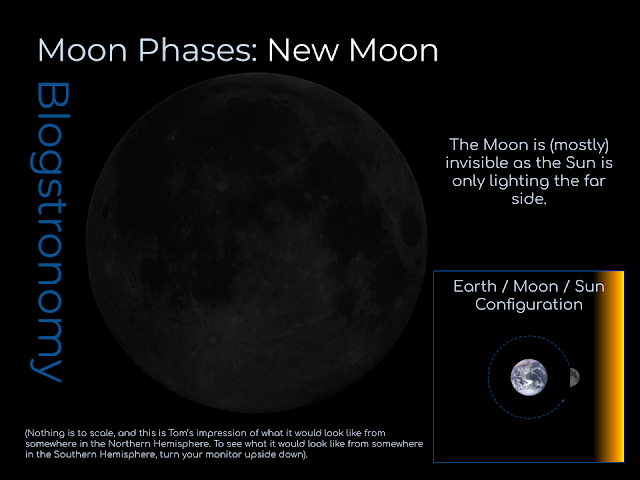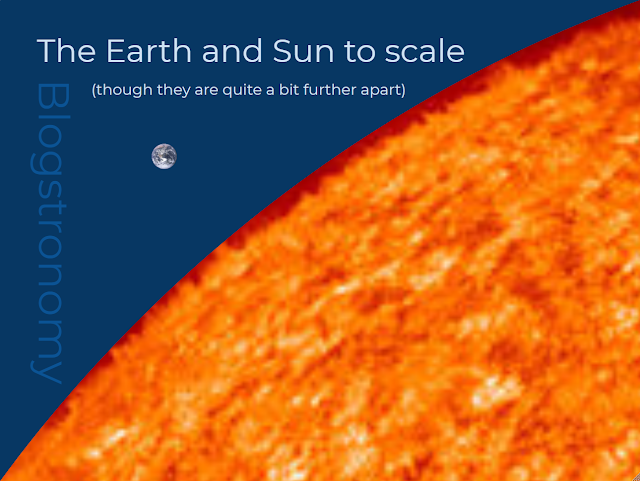Tell Me About the Phases of the Moon
Question posed by Dyana.
The Moon always has one half of it lit by the Sun*, and the other half in darkness**, but as it orbits us*** our viewpoint changes and we see a different portion of the lit half. The 'phases' of the Moon are our way of describing how much of the sunlit half of the Moon we can see.
We'll start the story with a phase which seems to make sense coming first:
New Moon
A new Moon is not particularly interesting to us as back-garden astronomers because we can't actually see it: the New Moon phase describes the time when the Moon is between the Sun and the Earth, so we are (in effect) viewing it from behind****, and there is no lit portion visible to us. Bear in mind that a new moon and a lunar eclipse are not the same thing (even though many people confuse them).
Waxing Crescent
As the first tiny toenail slither of the Moon starts to become visible (on the right-hand side, if you're in the Northern Hemisphere), the Moon has entered the phase known as 'waxing crescent'. As the Moon continues its orbit around us (anticlockwise, if you were hovering some way above the Earth's North Pole and looking down), this slither grows until the Moon enters the next phase, which is...
First Quarter
The first quarter is the instant when the right-hand 50% of the Moon is visible to us (again, only if you're in the Northern Hemisphere. In the Southern, it's the left-hand side because the Moon's the other way up). As the Moon continues onwards we enter the next phase.
Waxing Gibbous
Not 'gibbon', as a friend of mine has malapropped. Gibbons are monkeys*****. 'Waxing' means that the portion we can see is still growing larger (I like to think of the Karate Kid quote "wax on..."****** to help me remember), and 'gibbous' means that the portion we can see is more than 50% of the full Moon, which is the next phase:
Full Moon
When the Moon has waxed gibbous enough, we get a full Moon. This happens when the Moon is on the opposite side of the Earth to the Sun, which means that it's half way through its orbit from where we started this post, and we can see the whole of the lit face of the Moon in all its shining glory. There's only one way to go now: back into darkness. If you're paying attention, you'll see a certain symmetry between the previous three phases and the next three.
Waning Gibbous
Remember that 'gibbous' means that we can see more than 50% of the Moon's
surface, and I'll add that 'waning' means that this portion is now decreasing in
size (receding to the left, for us Northern Hemispherers) until we hit the...
Last Quarter
The first quarter was when, from our point of view (N.H.-ers, again) the right-hand half of the Moon was lit, so the last quarter is when the left-hand half of the Moon is lit up (Southern Hemispherers just swap the 'left's with the 'right's, and vice-versa). As the Moon continues its orbit, we see a...
Waning Crescent
This is the phase when we see the half-Moon shrink down into a thinner and thinner cut-toenail-shaped Moon, until it disappears altogether. Then we're back to the...
New Moon
* Actually, this isn't always true- during a lunar eclipse some (or all) of the lit surface is shaded by the Earth.
** Though there's no such thing as 'the dark side of the Moon' (regardless of which Pink Floyd albums you listen to). Ask me about this one sometime ;-)
*** Or, if you want to get pedantic about it, we orbit each other.
**** Note that the same 'side' of the Moon always faces us, so I'm talking about the 'front' of the Moon as being whichever bit is facing the Sun at any given time.
***** As a raging pedant, I have to correct myself here: Gibbons are apes, not monkeys.
****** Conveniently forgetting the other half of that quote.
Phases of the Moon Diagrams by T. Briggs is licensed under CC BY-NC-SA 4.0












Comments
Post a Comment